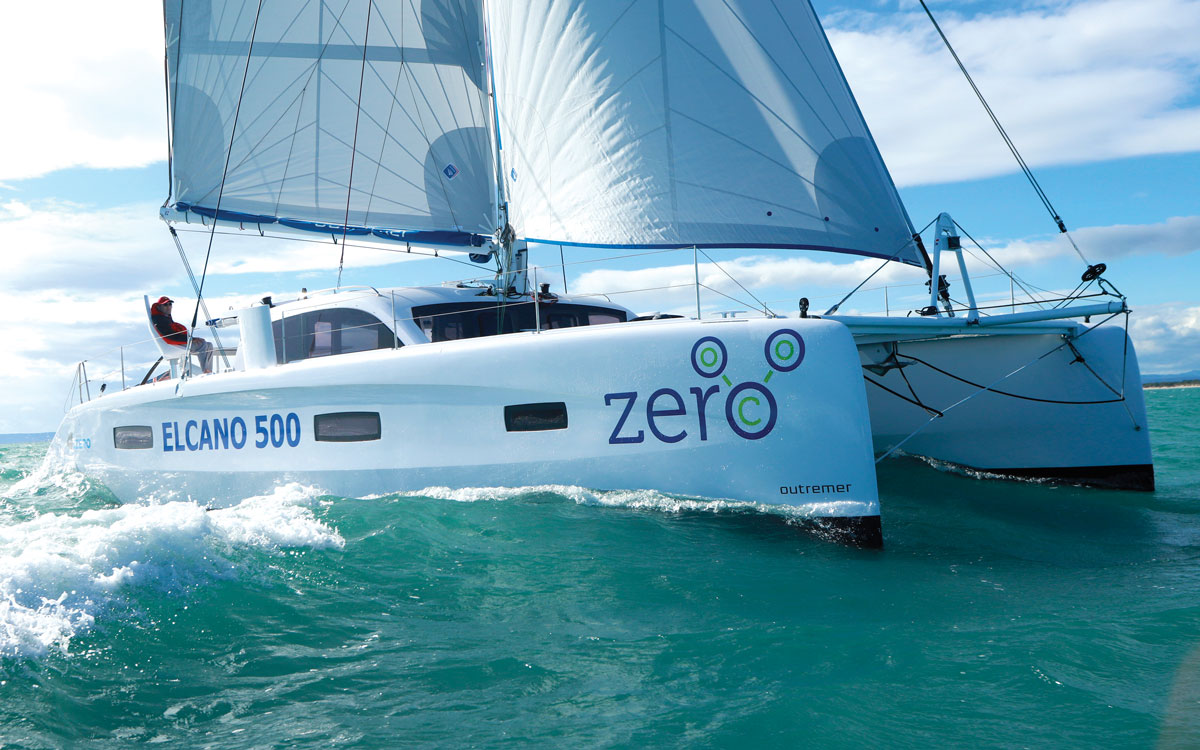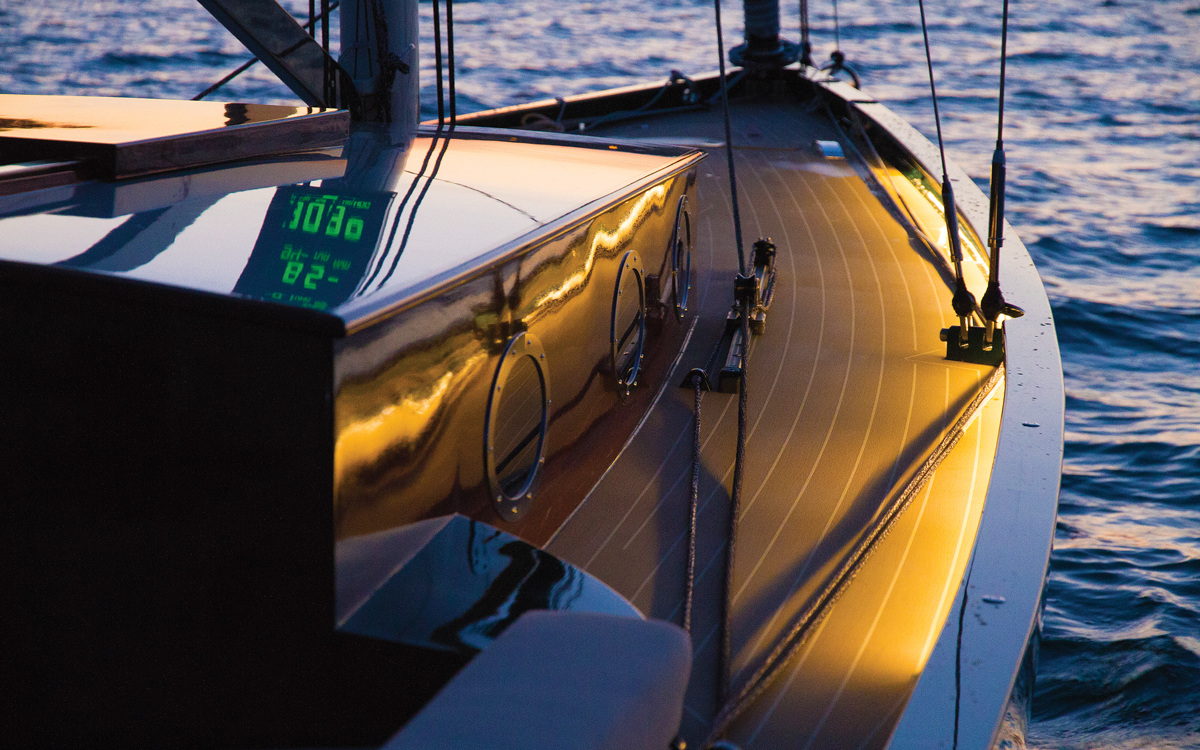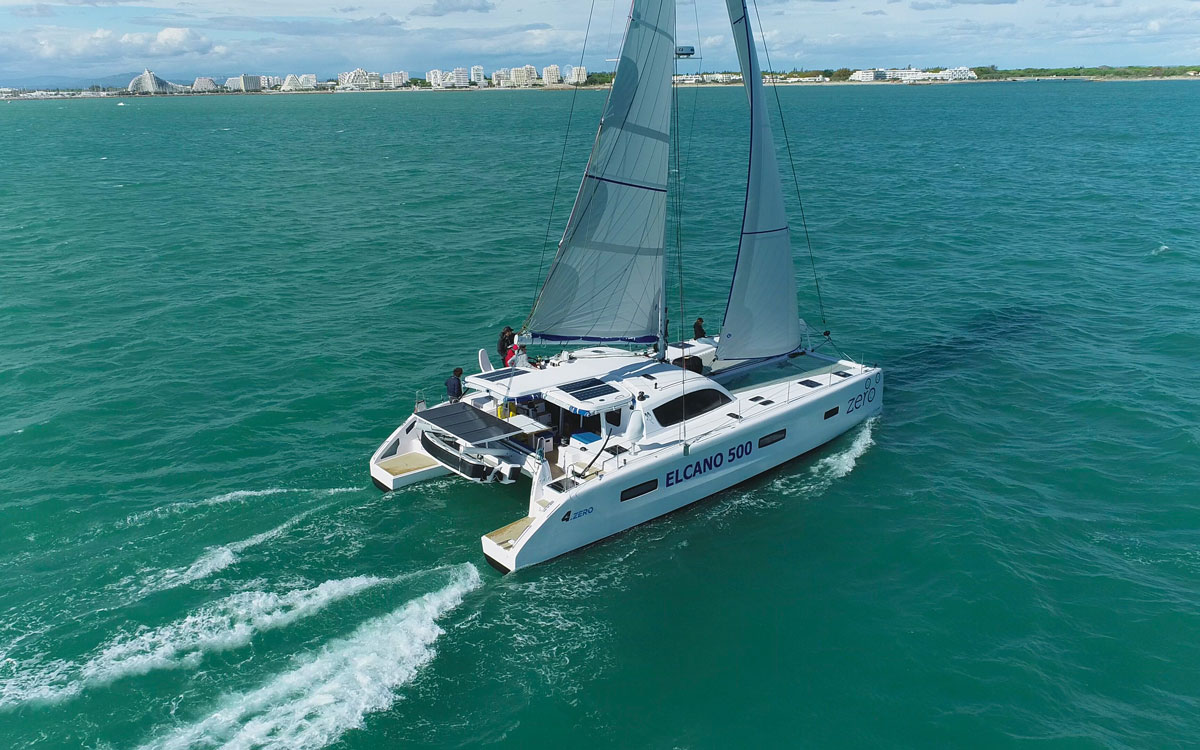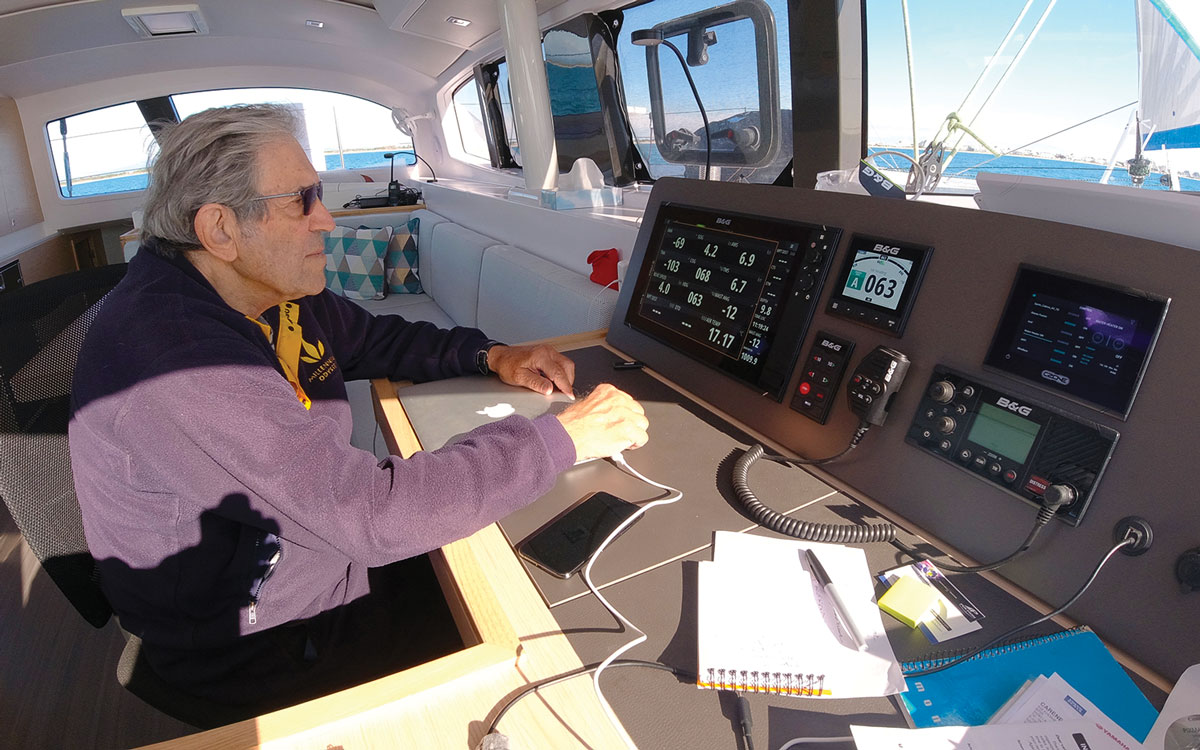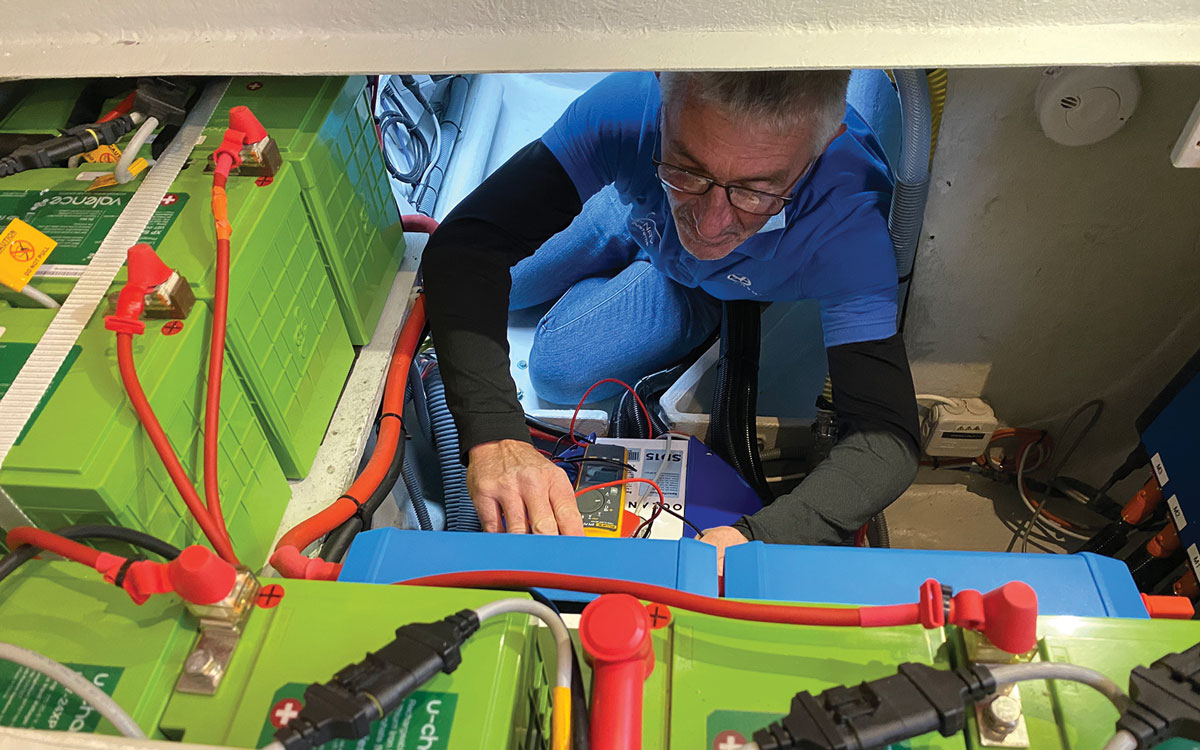Jimmy Cornell reports on his new catamaran, aboard which he plans a fossil-free circumnavigation
We couldn’t have picked a more miserable day to go out for our first sail on Aventura Zero. As we left the marina, grey skies hung low over the bay of La Grande Motte and it felt more like being in the North West Passage than the south of France. But once the sails were up, Aventura, a bespoke version of the Outremer 45, came alive and the magic took over.
As I took hold of the wheel, I felt a surge of mixed emotions: excitement, satisfaction, but above all a great relief that my complex and challenging project has become reality. I also felt 30 years younger.
Barely a year ago I realised that my active years were soon going to be over, and I ought to do something special, but also relevant, while still able to do it. This is how the idea was born of a round the world voyage in a fully electric boat along the route of the first circumnavigation 500 years ago.
As I explained in a previous report, even for a dyed-in-the-wool monohull sailor like myself opting for a catamaran seemed to be the best solution for the voyage I had in mind. A performance cruising catamaran would be fast under sail and thus able to generate electricity; it would also have sufficient surface available to display several solar panels.
Strangely enough, when I was planning my first voyage in the early 1970s, it was a catamaran that I believed would be best suited for a family with two young children. In those days, the UK was at the forefront of multihull development and there were several boatyards producing cruising catamarans.
The Snowgoose 35 and Iroquois looked very tempting, but when I approached the builders and told them that I could only afford their bare shells and would finish the rest myself, they both refused. So I had no choice but to go for a Van de Stadt Trintella III hull… and the rest is history.
Article continues below…
How hybrid sailing yachts finally became a feasible option
Every sailor is familiar with the wet cough of the diesel engine, and the acrid smell of its exhaust. For…
Lithium boat batteries: Why now is the right time to upgrade your electrics
Larger new cruising yachts, especially those at the quality end of the market, have been routinely fitted with lithium boat…
All about power
The main purpose of our sortie on that gloomy day was to test Aventura’s regeneration system. The essential feature of an electric boat concept is not its propulsion but the ability to produce electricity while sailing. It’s no good having an electricity-driven boat if you cannot produce electricity to replace what has been used; and that is the key element of the Oceanvolt system.
While sailing, the propellers on the two saildrives are turning and producing electricity. This is the concept of electric regeneration.
For reasons of security, Aventura has two different propellers. On the starboard side a variable pitch ServoProp, developed by Oceanvolt, is very efficient in producing electricity. The Gori folding propeller on the port side is less efficient in producing electricity but more efficient for propulsion and also more robust in case of a collision.
This is the potential weakness of the ServoProp and the reason for having chosen this compromise solution. As the ServoProp is highly efficient in generating electricity, it is capable of producing enough to cover 80% of the total output.
Initially, I had been told by Oceanvolt that we could expect an average charge of 600W at 6 knots and 800W at 8 knots, which sounded quite reasonable. But once Aventura got into her stride, we were achieving double those values, and much more at higher speeds.
Indeed, as our speed moved into double figures the ServoProp was charging the batteries at over 2kW, which was beyond my highest expectations… until Aventura caught a wave, started accelerating, the speed climbed to over 14 knots and the figure on the gauge shot up to 6.9kW!
The test also confirmed that the Gori propeller was much more efficient for propulsion, consuming less than half the electricity at the same revolutions than the ServoProp, while the latter produced on average as much as four times more electricity in regeneration mode compared to the Gori.
It will take more than a few hours’ sail to make an accurate assessment of the range under power, but in theory we should expect the two battery banks of 28kWh each to give us an autonomy of 10 to 12 hours at a cruising speed of 4 knots in light sea conditions, and perhaps 3 hours at 8 knots and full power.
A key feature of the Oceanvolt set up is its remote monitoring and management system. The entire Oceanvolt installation on Aventura Zero can be monitored in real-time over the internet. Thanks to this technology, Oceanvolt engineers are able to diagnose and deal with potential faults remotely from their base in Finland.
Via the remote interface it is possible to monitor overall power consumption and charging of the battery banks by hydro-regeneration or solar panels.
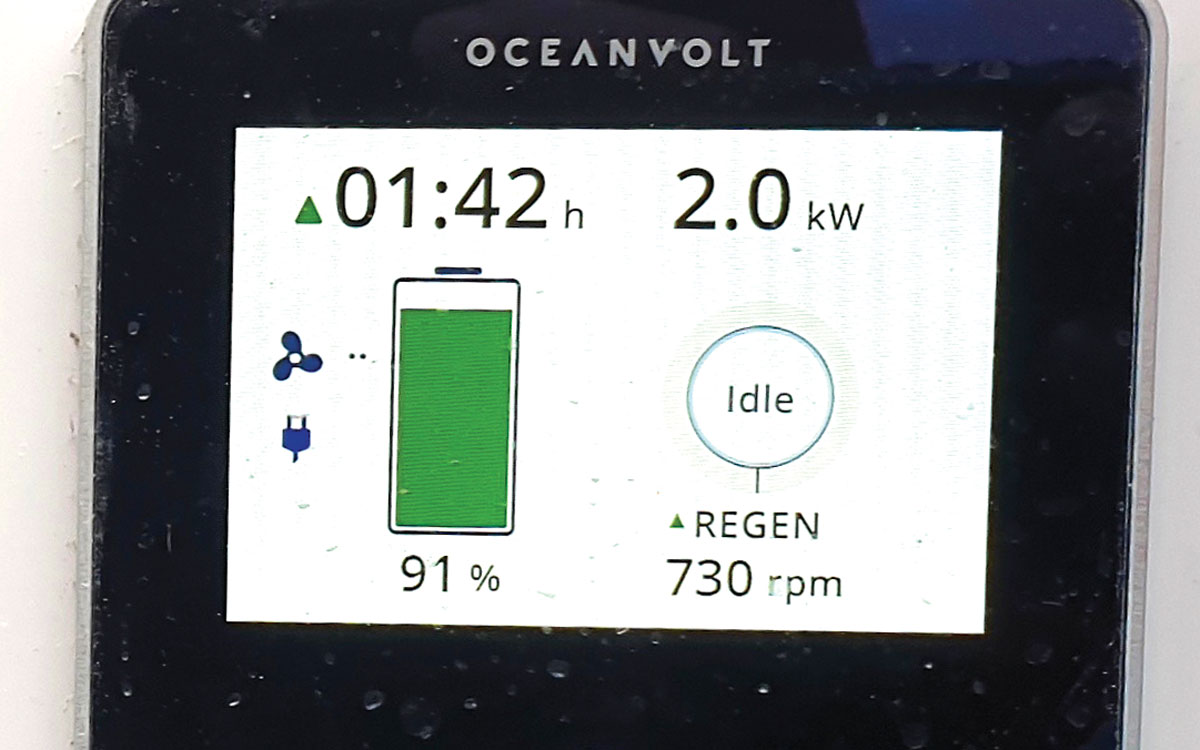
A pleasant surprise for Cornell and the test team as the display confirms the regenerative power coming from the Oceanvolt drive
Taming the performance
Having tested the Oceanvolt system, and with any concerns about its efficiency laid to rest, we spent the rest of the afternoon sailing up and down the bay, tacking and gybing in winds from 15 to 18 knots. With my monohull mentality, and aware of the speed potential of this type of cat, my main concern was how to keep matters under control quickly and efficiently when the need arose to depower the boat.
When I sailed last December from the Chesapeake Bay to Puerto Rico on an Outremer 5X rigged purely for racing, it took the three of us half an hour to put in a reef. That was something that I couldn’t accept and was determined to do better on my new boat. Now, with a simpler deck layout and the undisputed advantage of a rotating mast, we did it in less than half that time. We tacked and gybed, reefed upwind and reefed downwind, and it couldn’t have been easier.
Once done with slowing down the boat, we shook out the reef, turned into the wind and proceeded to test Aventura’s windward going capability. And this is where I had the greatest surprise, not of the day but of the entire testing sequence.
With full Solent and mainsail, the mast turned to 28° and the lee daggerboard down, Aventura was romping ahead at 9.5 knots at an apparent wind angle of 36° (true wind angle of 42°), and in 17 knots of true wind. I must be dreaming, I thought, before taking a photo to look at when I woke up.
A balmy day with a veritable Mediterranean sky worthy of a Cezanne painting smiled upon us as we left port the next day to continue testing the sails and deck layout. Lights winds and little swell provided ideal conditions to test the Code 0. Made of Aramid laminated cloth, it set beautifully and, once again, Aventura amazed me with her speed potential.
The turbo sails
Reaching in 10 to 14 knots of wind we were soon achieving the same speeds through the water. A sudden burst to 18.6 knots made me look twice at the speedometer to be sure I wasn’t reading the depth, while my crew were jumping up and down on the trampoline like kids in a playground.

“I am absolutely addicted to this versatile sail,” says Cornell of his fourth Parasailor. He believes more multihulls should carry them
The last in my sail wardrobe is a Parasailor, a spinnaker of a special design I have been using ever since its inventor Hartmut Schädlich sent one to me in New Zealand in 2004 to test on my return voyage to Europe. The latest is my fourth, as I am absolutely addicted to this versatile sail, which I can easily raise and douse on my own, as I did on this occasion.
For reasons that I cannot understand, Parasailor is little used or even known among many catamaran owners, so here was an opportunity to put this right. A fluky wind puffing between 5 and 10 knots offered me the ideal conditions to attempt to persuade my doubtful audience – Outremer sales manager Matthieu Rougevin-Baville and delivery skipper Julien Calvet.
The 210m2 monster played its role to perfection: it stayed full and steady in those light winds, and exceeded even my expectations when it kept Aventura moving at 6 knots in little over 7 knots of true wind. QED, but I am still waiting for my Gallic friends’ verdict.

Cornell with his crewmates: Americans Conor Dugan and Taylor Esposito, and Greek sailor Michalis Zacharias
Meanwhile, my crew’s verdict was as enthusiastic as they had been about everything else to do with this boat. Conor Dugan and Taylor Esposito are both Americans and have spent many years in the charter business in the Virgin Islands.
Having managed production catamarans of well-known brands, perfectly suited for charter guests but not very exciting to sail, witnessing the performance capability of Aventura was, in their words, “like having woken up in heaven”. My third crewmember is Michalis Zacharias, an experienced Greek sailor, who is just as excited at the prospect of a long voyage on such a boat.
Cooking on solar
Besides its outstanding performance, Aventura Zero also promises to be a comfortable home. Being fully electric will certainly add to that, although it will force us to adapt to a different lifestyle.
That certainly applies to the way we shall do our cooking, and keep an eye on the electricity consumption of such hungry items as water heater, hot plate, oven and breadmaker, all of which run off 220V.
The main energy storage is provided by the two propulsion battery banks of 28kWh each. The service battery, which supplies 12V to the electric winches, windlass and toilets, lights and various pumps, is recharged continuously from those banks.
As both battery banks are recharged continuously by the solar panels, with a total capacity of 1,300W, it makes sense for us to cook in the middle of the day, when their output would roughly equal that of consumption.
As we shall sail several long offshore passages, conserving fresh provisions is a high priority. The two fridge-freezers on Aventura Zero have a drawer-type mechanism which are much more efficient than the front-opening domestic type fridges used on many yachts today.
On the navigation side, the B&G Zeus3 is at the heart of a comprehensive system, which also includes a working autopilot and a backup. The latter has its own Triton display, GPS and wireless wind sensor, and is part of an emergency circuit entirely protected from the rest of the boat. It also has its own battery and Sail-Gen hydro-generator.
Satellite communications will be provided by Iridium Certus, the fastest L-band maritime service available. Throughout the voyage we shall automatically send data on wind speed and direction, barometric pressure, water and air temperature, to the World Meteorological Organisation, just as I did from the North West Passage.

Jimmy Cornell is marking the 500th anniversary of the first round the world voyage by sailing the same route as Basque sailor Juan Sebastian Elcano. His aim is to do so in an electric boat with a zero carbon footprint and he plans to set sail this November
A late addition to my range of electronics is OSCAR, an anti-collision device that detects floating objects up to 500m ahead, whether small boats, whales, containers or any other flotsam that could present a danger. It greatly improves safety both by day and night, and is the first navigational aid system based on artificial vision and intelligence. Currently it is used on some of the Vendée Globe yachts and our voyage will be a good test for its attraction on cruising boats.
Our tender is a lightweight OCT 330, built in New Zealand by Offshore Cruising Tenders. It is equipped with a Torqeedo 1103C electric outboard with a long-range, high-capacity 915W battery.
With autumn advancing fast and sailing conditions to the Canaries rapidly deteriorating, as soon as our tests and preparations are completed we shall sail for Seville and the symbolic start of our journey.
Because of the uncertain COVID situation in Brazil and also Argentina, we shall avoid calling anywhere in continental South America. After a brief stop in Tenerife we shall sail non-stop to Punta Arenas, in the Magellan Strait, a 6,000-mile leg that should prove that both boat and crew are worthy of following in the wake of our daring predecessors.
First published in the December 2020 issue of Yachting World. Since this report was published, Jimmy sailed to the Canaries, but during this passage came to the cruel realisation that the regeneration system was not going to give him the power required and had to make the difficult decision to return to the yard in France to evaluate further. For more information, check out his Cornell Sailing blog.




